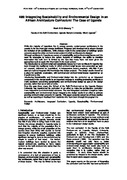| dc.description.abstract | While the majority of Ugandans live in energy poverty, contemporary architecture in the
country is for the most part energy inefficient. Progress and development is shown through
the inclusion of air-conditioners, while choices made in the construction of buildings ignore
concerns about the wider environmental context in which architecture is situated.
Although architects in Uganda are aware of sustainability and environmental issues and the
need for strategies to reduce the carbon footprint of buildings, the ability to translate
information into built form is limited by the fact that many have not been given the
appropriate tools to apply this information in the local context.
The introduction to environmental and sustainable issues for many architects in Uganda has
been through the traditional mode, in which environmental issues were presented as ‘addon’
courses, delivered by ‘specialists’, in independent lecture sessions, with little if any
attempt made to integrate this knowledge into design projects. The design studio viewed as
a place for aesthetic exploration, with technical and environmental issues regarded as an
impediment to this.
Introducing Sustainability and Environmental design into the curriculum as an integrated
component in the design studio is an important strategy to enabling graduating architects to
make decisions concerning sustainability and environmental design as part of the design
process, rather than as an add on extra.
Over the past three years, the School of the Built Environment at the Uganda Martyrs
University has transformed its curriculum in an effort to make the architecture curriculum
more responsive to environmental concerns. The new integrated curriculum sought to make
sustainability and environmental design integral to the design studio in an effort to address
growing environmental concerns in Uganda. This paper presents outcomes of these studios
as well as reporting on feedback from students who have been through the programme. | en_US |


